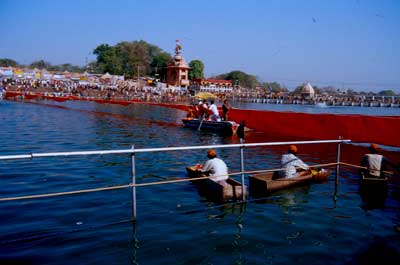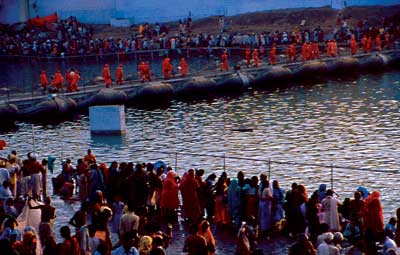|
Special Features
Simhastha at Ujjain in 2016 |
|||||
Ujjain, on the banks of the sacred Shipra river, is in the state of Madhya Pradesh, in central India. Here, the Simhastha is celebrated every 12 years. This is also the centre of Hindu timekeeping. Located at 23 degrees 11 minutes North and 73 degrees 45 minutes East, it is said that the Hindu astronomical treatise states that the prime meridian or the zero longitude traverses through Ujjain. Therefore time is reckoned by the sunrise at Ujjain and accordingly the beginning of a calendar year, Makar Samkranti, and the beginning of a Yuga are calculated from it. Ujjayini was also an ancient place of learning where the arts and sciences and the Vedas were taught in gurukuls. Lord Krishna is said to have attended a gurukul here along with his brother Balram. Legend has it that Shiva killed the demon Tripura at Ujjain on the banks of the Narmada. The name of Avantipura was said to have been changed to Ujjayini (one who conquers with pride). According to the Mahabharata's Aranya-parva, Ujjain is one of the seven sacred moksa-puris or sapta-puris. The others are Ayodhya, Mathura, Haridwar, Kashi (Varanasi), Kanchipuram, and Dwarka. Ujjain or City of Victory, is the modern name for Ujjayini. |
More on Kumbha •Nashik Kumbha 2015 • Ujjain 2016 • Legends of Kumbha • Practical Guide • Sadhus at Kumbha • Photo Gallery 1 • Photo Gallery 2 • Photo Gallery 3 • Kumbh Haridwar 2010 • Kumbha Allahabad 2013 • Ujjain 2004 • Notes from the Kumbh • Friend to Sage • Vignettes Kumbha Cities • Ujjain • Haridwar • Allahabad • Nashik | ||||
 There is an ancient banyan tree called Siddhwat, here. Many saints and sages have meditated here. According to legend, a ruler once had the tree cut down and covered the stump with iron plates. The next morning, the tree had burst through the iron plates and regained its original size.
There is an ancient banyan tree called Siddhwat, here. Many saints and sages have meditated here. According to legend, a ruler once had the tree cut down and covered the stump with iron plates. The next morning, the tree had burst through the iron plates and regained its original size. On the auspicious occasion of Simhastha, sadhus and sannyasins of various sects as well as pilgrims and devotees assemble in large numbers to take a sacred dip in the Shipra river. The gathering takes the form of a mammoth fair - the largest spiritual congregation of people anywhere on earth. Historians variously date the tradition of celebration of the Kumbha to the 7th and the 13th centuries. While the ruling kings were traditionally always deeply involved in all religious functions, there were no state arrangements for Simhastha during the Mughal period. The process of such arrangements started during the Maratha Period. In 1740 A.D., when the founder of the Shinde dynasty, Ranoji Shinde was ruling in Malwa with his headquarters at Ujjain, it was decided that it was the responsibility of the state to provide facilities to the pilgrims. Simultaneously, the sadhus of the Dashanami, Udasina, Natha, Vaisnavite and Saivite faiths were invited from Nasik to take part in the holy dips and to grace the occasion. There is archaeological evidence of such arrangements that have been located during exploration at Ujjain.
Pilgrims from all over India and abroad arrive in vast numbers. The international media now covers the event in minute detail. It has become a massive tourist extravaganza. It is a mammoth exercise in planning undertaken by the government, which spends crores to ensure a safe and peaceful event. Despite precautions, sometimes accidents do occur. It becomes imperative that any individual participating in this event takes personal responsibility to follow guidelines specified by the administration, maintain discipline, exercise caution and maintain the sanctity of the occasion. |
|||||
Editor: Romola Butalia (c) India Travelogue. All rights reserved. |
|||||
 Arrangements are made for the different Maths, groups and sects to camp at different dwelling places and to bathe at particular times. The leaders of the different sects have by consensus agreed on the modalities by which their processions and bathing will occur.
Arrangements are made for the different Maths, groups and sects to camp at different dwelling places and to bathe at particular times. The leaders of the different sects have by consensus agreed on the modalities by which their processions and bathing will occur.